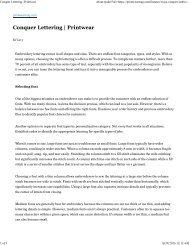Embroidery Basics Articles
You also want an ePaper? Increase the reach of your titles
YUMPU automatically turns print PDFs into web optimized ePapers that Google loves.
10/28/2016 Thick and Thin: So Many Fabrics...So Many ays W <strong>Embroidery</strong> Article<br />
Military precision! That’s the term that comes to mind when I think about hooping. Sloppy hooping presents more problems in<br />
embroidery than any other oversight, in my opinion.<br />
When a garment is properly hooped, the tension of the fabric will present a firm structure on which to place the design. In the case<br />
of knits, this must be done without stretching the fabric at all.<br />
Achieving an even tension in the hoop is easy enough. Just place the bottom portion of the hoop on the inside of the garment,<br />
centering it where the embroidery is going to be placed. The backing of choice should be between the hoop and the garment. On<br />
the outside of the garment, insert the top portion of the hoop. This placement is easy if you have a hooping aid. If not, the eye works<br />
well, too. Once the hoop is in place, a gentle tug on the fabric outside the hoop will increase the tension of the fabric. It is at this<br />
point that one must be careful not to pull the knits too much! When the hooping is complete, check to make sure that the lines<br />
created by the weave, commonly called the grain of the fabric, are straight in both directions, vertically and horizontally .<br />
Backing and Topping<br />
There are many backings available and experienced embroiderers will easily tell you about their favorites. They are divided into two<br />
categories, cutaway and tearaway . Our backing of choice is most often a medium cutaway . Cutaway backings provide more stability<br />
than tearaway, simply because they do not pull apart in the embroidery process. T earaway backings weaken, especially around the<br />
edges of the design, with each needle penetration. The nice part of using a tearaway , though, is that removal is easy and the inside<br />
of the garment looks nicer and is more comfortable against the skin when there is no unsightly backing left around the edges of a<br />
design.<br />
Because of the properties of the dif ferent types of fabrics in our order , we will choose dif ferent types of backing. Medium tearaway<br />
backings will be suf ficient for the stable fabrics in the twill coats, the bags, and the caps. The CD cases would present a dif ferent<br />
problem in that they cannot be hooped with ordinary methods. They could either be embroidered with a specialty frame or by<br />
placing them on sticky backing using a standard frame.<br />
Knit fabrics need a stronger foundation to prevent movement during the embroidery . In general, a good rule to follow is that the less<br />
stable a fabric is, the more stable the backing must be. The fear when embroidering polo shirts or lightweight T shirts is that the<br />
backing will show through the garment. Another concern is that, in most cases, the embroidery will lie against the skin when the<br />
garment is worn, and very heavy backings are often uncomfortable. Mesh backings are great when the embroiderer needs the<br />
stability of a cutaway backing, but is also concerned that the backing will show through the garment. The mesh is translucent, and<br />
is lightweight, allowing for better draping of the garment than traditional heavier backings.<br />
There are many choices and it takes a bit of research and experimenting to find what works best for you.<br />
Finishing<br />
When my mom was teaching me to sew as a young child, she would always tell me that the inside of the garment should look as<br />
good as the outside. I also remember , when entering the 4H competitions at the local county fairs, the agonizing moments when<br />
the judge would turn that garment inside out and inspect the stitches of every seam, making sure that the construction techniques<br />
were done correctly, that the stitches were even, that the upper and lower tension of the machine were set correctly and that all<br />
ends of the thread were clipped.<br />
This is the same care that should be taken in the finishing of a garment that comes of f the embroidery machine. Backing should be<br />
removed. With tearaway, that is simple. It is usually already cut away by the stitches, and a little tug will remove the excess from the<br />
edges of the design. Cutaway requires more care in that you need to cut close to the design without actually clipping any of the<br />
stitches. As for the rest of the design, the machines should have been properly set before embroidery , but clipping any unsightly<br />
threads will also make the design picture perfect.<br />
…And isn’t that what we are trying to achieve? Picture perfect embroidery on every piece!<br />
More From This Author<br />
Redwork Baby Quilt By Barbara Geer<br />
Redwork Baseball Quilt By Barbara Geer<br />
Play Food By Barbara Geer<br />
Share this project: 0 0 0<br />
https://www.embroiderydesigns.com/emb_learning/article/559/thickandthinsomanyfabricssomanyways.aspx 3/4




